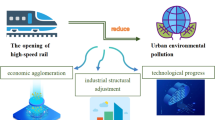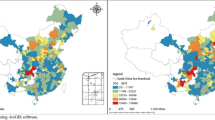Abstract
In response to climate change and energy conservation and emission reduction targets, the green development of transportation has become one of the most concerned topics in the world. Many studies have verified the impact of intra-city rail on environmental pollution, but little attention has been paid to the environmental effects of inter-city railway. This paper based on data on 108 cities in the Yangtze River Economic Belt from 2003 to 2018 takes high-speed rail as a “quasi-natural experiment” and conducts empirical tests on the emissions reduction effect, impact mechanism, and spatial spillover effect of high-speed rail using a multi-phase difference-in-difference model, a mediating effect model, and a spatial difference-in-difference model. The findings are as follows. (1) High-speed rail is conducive to reduction in environmental pollution in the Yangtze River Economic Belt, and as the opening time of the high-speed rail continues, the emission reduction effect of the high-speed rail is gradually increasing. (2) High-speed rail has a more significant inhibiting impact on environmental pollution in cities in the upper and lower reaches of the Yangtze River and cities listed in the “two control areas.” (3) Industrial upgrading and human capital accumulation form an important transmission mechanism for high-speed rail to achieve emissions reduction. (4) High-speed rail has a significant positive spatial spillover effect, which aggravates the level of environmental pollution in the surrounding areas of cities along the route.

Similar content being viewed by others
Availability of data
The data are available from authors upon request.
Notes
China State Railway Group (www.china-railway.com.cn).
The upper reaches of the YREB include Yunnan Province, Guizhou Province, Sichuan Province, and Chongqing Municipality; middle reaches include Hunan Province, Hubei Province, and Jiangsu Province; lower reaches include Anhui Province, Zhejiang Province, Jiangsu Province, and Shanghai.
Abbreviations
- HSR:
-
High-speed rail
- YREB:
-
Yangtze River Economic Belt
- DID:
-
Difference-in-difference
- SDID:
-
Spatial difference-in-difference
- FDI:
-
Foreign direct investment
- HL:
-
Rationalization of the industrial structure
- PSM–DID:
-
Propensity score matching–difference-in-difference.
- SUTVA:
-
Stable unit treatment value assumption
References
Albalate D, Campos J, Jiménez JL (2017) Tourism and high speed rail in Spain: Does the AVE increase local visitors? Ann Tour Res 65:71–82
Adejumo OO (2020) Environmental quality vs economic growth in a developing economy: complements or conflicts. Environ Sci Pollut Res 27(6):6163–6179
Bian YC, Wu LH, Bai JH (2019) Does high-speed rail improve regional innovation in China? J Financ Res 6:132–149
Candau F, Dienesch E (2017) Pollution haven and corruption paradise. J Environ Econ Manag 85(9):171–192
Chang B, Kendall A (2011) Life cycle greenhouse gas assessment of infrastructure construction for California’s high-speed rail system. Transport Res Part D-Tr E 16(6):429–434
Chen CL, Hall P (2011) The wider spatial-economic impacts of high-speed trains: a comparative case study of the Lille and Manchester sub-regions. J Transp Geogr 24(4):89–110
Chen L, Zhao X, Li L (2015) Forecast of transportation carbon emissions and scenario analysis in Jiangsu Province. Environ Sci Manag 40(10):13–17
Chen Y, Whalley A (2012) Green infrastructure: the effects of urban rail transit on air quality. Am Econ J Econ Pol 4(1):58–97
Cheng Z, Xu Q, Sanderson IF (2021) China's economic growth and haze pollution control. Nat Hazards 107(3):2653–2669
Cole MA, Elliott RJR (2003) Determining the trade-environment composition effect: the role of capital, labor and environmental regulations. J Environ Econ Manag 46(3):363–383
Deng H, Yang L, Pan X (2020) High-speed rail and industrial upgrading in China: facts and mechanisms. J Finance Econ 46(6):34–48
Deng YP, Xu HL (2013) Foreign direct investment, local government competition and environmental pollution: empirical analysis on fiscal decentralization. China Popul Resour Environ 23(7):155–163
Dong X, Zheng S, Kahn M (2020) The role of transportation speed in facilitating high skilled teamwork across cities. J Urban Econ 115:103212
Fu S, Gu Y (2017) Highway toll and air pollution: evidence from Chinese cities. J Environ Econ Manag 83(5):32–49
Fu X (2008) Foreign direct investment, absorptive capacity and regional innovation capabilities: evidence fROM China. Oxf Dev Stud 36(1):89–110
Gan C, Zheng R, Yu D (2011) An empirical study on the effects of industrial structure on economic growth and fluctuations in China. Econ Res J 21(1):85–100
Gao M, Chen LQ, Guo SH (2018) Rail transit, BRT and air quality: a view of urban heterogeneity. China Popul Resour Environ 28(6):73–79
Han Y, Huang L, Wang X (2015) Does upgrading of industrial structure improve ecological civilization: local effects and interregional influences. Finance & Trade Economics 12:129–146
Huang S (2017) A study of impacts of fiscal decentralization on smog pollution. J World Econ 40(2):127–152
Li S, Liu Y, Purevjav AO et al (2019) Does subway expansion improve air quality? J Environ Econ Manag 96:213–235
Li Z, Yang SY (2019) Can national high-tech zones raise urban innovation level? South China J Econ 12:49–67
Liang RB, Xi PH (2016) Heterogeneous effects of rail transit on air pollution—an empirical study with RDID. China Ind Econ 3:83–98
Lu FZ, Yang HC (2019) Environmental decentralization, local government competition and China’s ecological environment pollution. Ind Econ Res 4:113–126
Lu YG (2020) The Yangtze River Delta railway: write a high-quality development answer sheet first. Shanghai Enterprise 6:22–25
Luo NS, Tian MD, Yang J, Li JM, Wang YZ (2019) Impact of high-speed rail network on urban eco-efficiency: based on the spatial measurement of 277 prefecture-level cities nationwide. China Popul Resour Environ 29(11):1–10
Ma LM, Liu SL, Zhang X (2016) Study on Haze pollution induced by energy structure and transportation: based on spatial econometric model analysis. Finance Trade Econ 37(1):147–160
Oates WE (1999) An essay on fiscal federalism. J Econ Lit 37(3):1120–1149
Ouarda BL (2019) Effects of energy prices on environmental pollution: Testing environmental kuznets curve for Algeria. Int J Energy Econ Policy 9(5):401–408
Poon JPH, Casas I, He C (2006) The impact of energy, transport, and trade on air pollution in China. Eurasian Geogr Econ 47(5):568–584
Qin FM, Zhang Y, Liu ZN (2019) Does high-speed rail promote regional human capital?——An empirical test based on difference in differences model. Shanghai J Econ 11:70–83
Sapkota P, Bastola U (2017) Foreign direct investment, income, and environmental pollution in developing countries: Panel data analysis of Latin America. Energy Econ 64:206–212
Shi DQ, Ding H, Wei P, Liu JJ (2018) Can smart city construction reduce environmental pollution. China Ind Econ 6:117–135
Sun GZ, Huang KN (2019) An analysis of the heterogeneous impact of the high-speed rail opening on the growth rate of total factor productivity. J Finance Econ 45(5):84–98
Tang CF, Tan BW (2015) The impact of energy consumption, income and foreign direct investment on carbon dioxide emissions in Vietnam. Energy 79(1):447–454
Tang Z, Mei Z, Zou J (2021) Does the opening of high-speed railway lines reduce the carbon intensity of china’s resource-based cities? Energies 14(15):4648. https://doi.org/10.3390/en14154648
Wen J, Zakaria M, Syed JHS, Mahmood H (2018) Effect of FDI on pollution in China: New insights based on wavelet approach. Sustain 10(11):3859
Wu X, Gao M, Guo S, Li W (2019) Effects of environmental regulation on air pollution control in China: A spatial durbin econometric analysis. J Regul Econ 55(3):307–333
Wang F, Wu L, Yang C (2010) Driving factors for growth of carbon dioxide emissions during economic development in China. Econ Res J 45(2):123–136
Yang X, Lin S, Li Y, He M (2019) Can high-speed rail reduce environmental pollution? Evidence from China. J Clean Prod 239:118135
Yue Y, Wang T, Liang S et al (2015) Life cycle assessment of high speed rail in China. Transport Res Part D-Tr E 41:367–376
Zhang H (2021) The impact of urban sprawl on environmental pollution: Empirical analysis from large and medium-sized cities of China. Int J Env Res Pub He 18(16):8650
Zhang TF, Yang J, Sheng PF (2016) The impacts and channels of urbanization on carbon dioxide emissions in China. China Popul Resour Environ 26(2):47–57
Zhang J, Zhang K, Zhao F (2020) Spatial effects of economic growth, energy consumption and environmental pollution in the provinces of China–An empirical study of a spatial econometrics model. Sustain Dev 28(4):868–879
Zhao LD, Zhang L, Xu L, Hu MZ (2016) Mechanism of human capital, industrial structure adjustment and green development efficiency. China’s Popul Resour Environ 26(11):106–114
Zheng L, Guo X, Zhao L (2021) How does transportation infrastructure improve corporate social responsibility? Evidence from high-speed railway openings in china. Sustainability 13(11):6455. https://doi.org/10.3390/su13116455
Zheng S, Kahn ME (2013) Understanding China’s urban pollution dynamics. J Econ Lit 51(3):731–772
Zheng S, Zhang X, Sun W, Wang J (2019) The effect of a new subway line on local air quality: a case study in Changsha. Transp Res Part d: Transp Environ 68:26–38
Zhou M, Wang B, Chen Z (2020) Has the anti-corruption campaign decreased air pollution in China? Energy Econ 91:104878
Zugravu-soilita N (2017) How does foreign direct investment affect pollution? Toward a better understanding of the direct and conditional effects. Environ Reso Econ 66(2):293–338
Acknowledgements
We would like to thank our editor and anonymous reviewer(s) for their valuable comments. This research is funded by the National Social Science Fund in the late stage of the project "Study on the Emission Reduction Effect of environmental decentralization from the perspective of River Chief System" (19FJLB004); Research on the Major Issues of high-quality Integrated Development in the Yangtze River Delta: Study on the Long-term Mechanism of Environmental Governance in the Yangtze River Delta Based on Environmental Decentralization (AHSKC2019D02). The Key Program of National Natural Science Foundation of China (71934005). The General Program of National Natural Science Foundation of China (71773051). The National Social Science Foundation of China (21BJL102).
Author information
Authors and Affiliations
Contributions
Li and Zhang conceived the idea and provided the data; Li and Dong conducted the analyses; all authors contributed to the writing and revisions. All authors have given approval to the final version of the manuscript.
Corresponding author
Ethics declarations
Conflict of interest
The authors declare that they have no competing interests.
Ethical approval
The submitted paper meets the ethical standards set by International Journal of Environmental Science and Technology.
Consent to participate
Not applicable.
Consent for publication
Not applicable.
Additional information
Editorial responsibility: Nour Sh. El-Gendy.
Rights and permissions
About this article
Cite this article
Li, Q., Dong, A. & Zhang, B. Impact of the opening of high-speed rail on environmental pollution in the Yangtze River Economic Belt: Promoting or inhibiting?. Int. J. Environ. Sci. Technol. 19, 11145–11160 (2022). https://doi.org/10.1007/s13762-021-03860-8
Received:
Revised:
Accepted:
Published:
Issue Date:
DOI: https://doi.org/10.1007/s13762-021-03860-8




